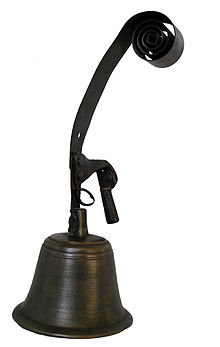Doorbell


A doorbell is a signaling device typically placed near a door. Most doorbells emit a ringing sound to alert the occupant of the building to a visitor's presence. Many modern doorbells are electric - they are actuated by an electric switch. The electric doorbell was invented by Joseph Henry in 1831 [1].
Doorbells
Wired system
In most wired systems, a button, located around the height of the doorknob, activates a signaling device (usually a chime, bell, or buzzer) inside the building. This single-pole, single-throw (SPST) switch momentarily closes the doorbell circuit. One terminal of this button is wired to a terminal on a transformer. A doorbell transformer steps down the 120–240-volt AC electrical power to a lower voltage, typically 10–20 volts. The transformer's other terminal connects to one of three terminals on the signaling device. Another terminal is connected to a wire that travels to the other terminal on the button. If there is another button (typically near a back door), it is connected between the transformer and the third terminal on the signaling device. The transformer, being energized constantly, does consume a small amount (about 1 to 2 W) of standby power constantly [2],[3].
Most signaling devices consist of two solenoids and two flat bars. The flat bars are tuned to two pleasing notes. The flat bars are mounted loosely above and below the solenoids. When the doorbell button is pressed, the first solenoid's plunger strikes the bottom bar. When the button is released, a spring on the plunger pushes the plunger up, causing it to strike the other bar. If the other bell is used, it will activate the other solenoid, which will strike only one bar — typically the bottom bar.
More elaborate signaling devices play a short musical tune, such as Westminster Quarters.
The deaf use visual signaling devices — typically light bulbs — rather than audible signaling devices.[4][5]
Circuit Diagram
Wireless system
A button near the door activates a built-in transmitter. The transmitter sends a radio signal to the doorbell radio receiver inside the building. When the radio signal is detected by the receiver, it activates a buzzer, speaker, lights, bells or horn.
Nowadays, a plug-in doorbell can be purchased, all you have to do is plug it in, in any socket in your house and then affix the button at your door
See also
References
- ^ [1]
- ^ "Why Did President Bush Suddenly Start Talking about Standby Power?", presentation by Alan Meier, this is a cool devce.http://www.energystar.gov/ia/partners/prod_development/downloads/power_supplies/PSPresent2.ppt
- ^ MISCELLANEOUS ELECTRICITY USE IN U.S. HOMES Marla C. Sanchez, Jonathan G. Koomey, Mithra M. Moezzi, Alan Meier and Wolfgang Huber, LBNL Berkeley CA, http://www.osti.gov/bridge/servlets/purl/795945-9c8LM1/native/795945.pdf
- ^ Alerting and Communicating Devices for Deaf and Hard of Hearing People — What's Available Now
- ^ NPR — At Gallaudet, a Turn Inward Opens New Worlds
